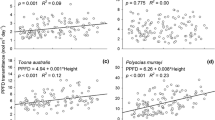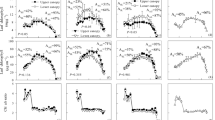Abstract
Dependencies of foliage arrangement and structure on relative irradiance and total height (TH) were studied in saplings ofAcer platanoides andQuercus robur. The distribution of relative foliar area and dry weight (leaf area and weight in a crown layer per total tree leaf area and weight, respectively) were examined with respect to relative height (RH, height in the crown per TH) and characterized by the Weibull function. The distributions of relative area and weight were nearly identical, and the differences between them were attributable to a systematic decline in leaf dry weight per area with increasing crown depth. Foliage distribution was similarly altered by tree size in both species; RH at foliage maximum was lower and relative canopy size (RCS, length of live crown per TH) greater in taller trees. However, the distribution was more uniform inA. platanoides than inQ. robur. Apart from the size effects, relative irradiance also influenced canopy structure; RCS increased inQ. platanoides and decreased inQ. robur with increasing irradiance. As crown architecture was modified by irradiance, foliage distribution was shifted upwards with decreasing irradiance inA. platanoides, but it was independent of irradiance inQ. robur. Higher foliage maximum at lower irradiance in more shade-tolerantA. platanoides is likely to contribute towards more efficient foliar display for light interception and increase the competitive ability of this species in light-limited environments. Consequently, these differences in crown architecture and foliage distribution may partly explain the superior behavior ofA. platanoides in understory.
Similar content being viewed by others
References
Abrams M. D. &Kubiske M. E. (1990) Leaf structural characteristics of 31 hardwood and conifer tree species in Central Wisconsin: influence of light regime and shade-tolerance rank.Forest Ecology and Management 31: 245–253.
Anderson M. C. (1964) Studies of the woodland light climate. I. The photographic computation of light conditions.The Journal of Ecology 52: 27–41.
Ardhana I. P. G., Takeda H., Sakimoto M. &Tsutsumi T. (1988) The vertical foliage distributions of six understory tree species in aChamaecyparis obtusa Endl. forest.Trees: Structure and Function 2: 143–149.
Boojh R. &Ramakrishnan P. S. (1982) Growth strategy of trees related to successional status. I. Architecture and extension growth.Forest Ecology and Management 4: 359–374.
Borchert R. &Tomlinson P. B. (1984) Architecture and crown geometry inTabebuia rosea (Bignoniaceae).American Journal of Botany 71: 958–969.
Canham C. D. (1988) Growth and canopy architecture of shade-tolerant trees: response to canopy gaps.Ecology 69: 786–795.
Canham C. D., Finzi A. C., Pacala S. W. &Burbank D. H. (1994) Causes and consequences of resource heterogeneity in forests: interspecific variation in light transmission by canopy trees.Canadian Journal of Forest Research 24: 337–349.
Čermak J. (1989) Solar equivalent leaf area: an efficient biometrical parameter of individual leaves, trees and stands.Tree Physiology 5: 269–289.
Cornelissen J. H. C. (1993) Aboveground morphology of shade-tolerantCastanopsis fargesii saplings in response to light environment.International Journal of Plant Sciences 154: 481–495.
Ellenberg H., Weber H. E., Düll R., Wirth V., Werner W. &Paulißen D. (1991)Zeigerwerte von Pflanzen in Mitteeuropa. Scripta Geobotanica Vol. 18. Verlag Erich Goltze KG, Göttingen.
Ellworth D. S. &Reich P. B. (1993) Canopy structure and vertical patterns of photosynthesis and related leaf traits in a deciduous forest.Oecologia 96: 169–178.
Ford E. D. (1982) High productivity in a pole stage Sitka spruce stand and its relation to canopy structure.Forestry 55: 1–17.
Givnish T. (1979) On the adaptive significance of leaf form. In:Topics in Plant Population Biology (eds O. T. Solbrig, S. Jain, G. B. Johnson & P. H. Raven) pp. 375–407 Columbia University Press, New York.
Hagihara A. &Hozumi K. (1986) An estimate of the photosythetic production of individual trees in aChamaecyparis obtusa plantation.Tree Physiology 1: 9–20.
Hara T., Kimura M. &Kikuzawa K. (1991) Growth patterns of tree height and stem diameter in populations ofAbies veitchii, A. mariesii andBetula ermanii.The Journal of Ecology 79: 1085–1098.
Hashimoto R. (1990) Analysis of the morphology and structure of crowns in a young sugi (Cryptomeria japonica) stand.Tree Physiology 6: 119–134.
Hollinger D. Y. (1989) Canopy organization and foliage photosynthetic capacity in broad-leaved evergreen montane forest.Functional Ecology 3: 53–62.
Horn H. S. (1971)The Adaptive Geometry of Trees. Princeton University Press, Princeton, New Jersey.
Jurik T. W. (1986) Temporal and spatial patterns of specific leaf weight in successional northern hardwood tree species.American Journal of Botany 73: 1083–1092.
King D. A. (1990) The adaptive significance of tree height.The American Naturalist 135: 809–829.
King D. A. (1991) Correlations between biomass allocation, relative growth rate and light environment in tropical forest saplings.Functional Ecology 5: 485–492.
Kohyama T. (1980) Growth pattern ofAbies mariesii saplings under conditions of open-growth and suppression.The Botanical Magazine, Tokyo 93: 13–24.
Kohyama T., Hara T. &Tadaki Y. (1990) Patterns of trunk diameter, tree height and crown depth in crowdedAbies stands.Annals of Botany 65: 567–574.
Koike T. (1986) Photosynthetic responses to light intensity of deciduous broad-leaved tree seedlings raised under various artificial shade.Environment Control in Biology 24: 51–58.
Kull O. &Niinemets Ü. (1993) Variation in leaf morphometry and nitrogen concentration inBetula pendula Roth.,Corylus avellana L. andLonicera xylosteum. L.Tree Physiology 12: 311–318.
Kurachi N., Hagihara A. &Hozumi K. (1992) Canopy photosynthetic production in a Japanese larch stand. I. Seasonal and vertical changes of leaf characteristics along the light gradient in a canopy.Ecological Research 7: 255–265.
Linder S. (1985) Potential and actual production in Australian forest stands. In:Research for Forest Management (eds J. J. Landsberg & W. Parsons) pp. 11–35, CSIRO, Melbourne.
Monsi M. &Saeki T. (1953) Über den Lichtfaktor in den Pflanzengesellschaften und seine Bedeutung für die Stoffproduktion.Japanese Journal of Botany 14: 22–52.
Mori S. &Hagihara A. (1991) Crown profile of foliage area characterized with the Weibull distribution in a hinoki (Chamaecyparis obtusa) stand.Trees: Structure and Function 5: 149–152.
Niinemets Ü. (1995) Distribution of foliar carbon and nitrogen across the canopy ofFagus sylvatica: adaptation to a vertical light gradient.Acta Oecologica 16: 525–541.
Niinemets Ü (1996) Distribution patterns of foliar carbon and nitrogen as affected by tree dimensions and relative light conditions in the canopy ofPicea abies. Trees: Structure and Function (in press).
Niinemets Ü. &Kull K. (1994) Leaf weight per area and leaf size of 85 Estonian woody species in relation to shade tolerance and light availability.Forest Ecology and Management 70: 1–10.
Niinemets Ü. &Kull O. (1995) Effects of light availability and tree size on the architecture of assimilative surface in the canopy ofPicea abies: variation in needle morphology.Tree Physiology 15: 307–315.
Nilson T. &Ross V. (1979) Characterization of the transparency of a forest canopy by fish-eye photographs. In:Spruce Forest Ecosystem Structure and Ecology. Vol. 2. Basic data on the Estonian Vooremaa project (ed. T. Frey) Estonian IBP Report 12. pp. 114–130. Academy of Sciences of the Estonian S.S.R. Estonian Republican Committee for IBP, Tartu.
Oberbauer S. F., Clark D. B., Clark D. A. &Quesada M. (1988) Crown light environments of saplings of two species of rain forest emergent trees.Oecologia,75: 207–215.
O'Connell B. M. &Kelty M. J. (1994) Crown architecture of understory and open-grown white pine (Pinus strobus L.) saplings.Tree Physiology 14: 89–102.
Ojea I., Pereiras J. &Basanta M. (1988) Vertical distribution of photosynthetic and non-photosynthetic phytomass inUlex europaeus. In:Plant Form and Vegetation Structure. Adaptation, Plasticity and Relation to Herbivory. (eds M. J. A. Werger, P. J. M. van der Aart, H. J. During & J. T. A. Verhoeven) pp. 183–190, SPB Academic Publishing, The Hague.
Oren R., Schulze E.-D., Matyssek R. &Zimmermann R. (1986) Estimating photosynthetic rate and annual carbon gain in conifers from specific leaf weight and leaf biomass.Oecologia 70: 187–193.
Ovington J. D. &MacRae C. (1960) The growth of seedlings ofQuercus petraea.The Journal of Ecology 48: 549–555.
Schreuder H. T. &Swank W. T. (1974) Coniferous stands characterized with the Weibull distribution.Canadian Journal of Forest Research 4: 518–523.
Steingraeber D. A., Kascht L. J. &Frank D. H. (1979) Variation of shoot morphology and bifurcation ratio in sugar maple (Acer saccharum) saplings.American Journal of Botany 66: 441–445.
Washitani I. &Tang Y. (1991) Microsite variation in light availability and seedling growth ofQuercus serrata in a temperate pine forest.Ecological Research 6: 305–316.
White P. S. (1983) Corner's rules in eastern deciduous trees: allometry and its implications for the adaptive architecture of trees.Bulletin of the Torrey Botanical Club 110: 203–212.
Wilkinson L. (1990)SYSTAT: The System for Statistics. SYSTAT, Inc., Evanston, IL.
Yamamura Y., Ishida A. &Hori Y. (1993) Differences in sapling architecture betweenFagus crenata andFagus japonica.Ecological Research 8: 235–239.
Author information
Authors and Affiliations
About this article
Cite this article
Niinemets, Ü. Changes in foliage distribution with relative irradiance and tree size: Differences between the saplings ofAcer platanoides andQuercus robur . Ecol. Res. 11, 269–281 (1996). https://doi.org/10.1007/BF02347784
Received:
Accepted:
Issue Date:
DOI: https://doi.org/10.1007/BF02347784




